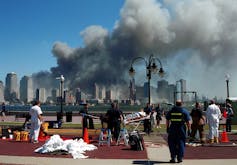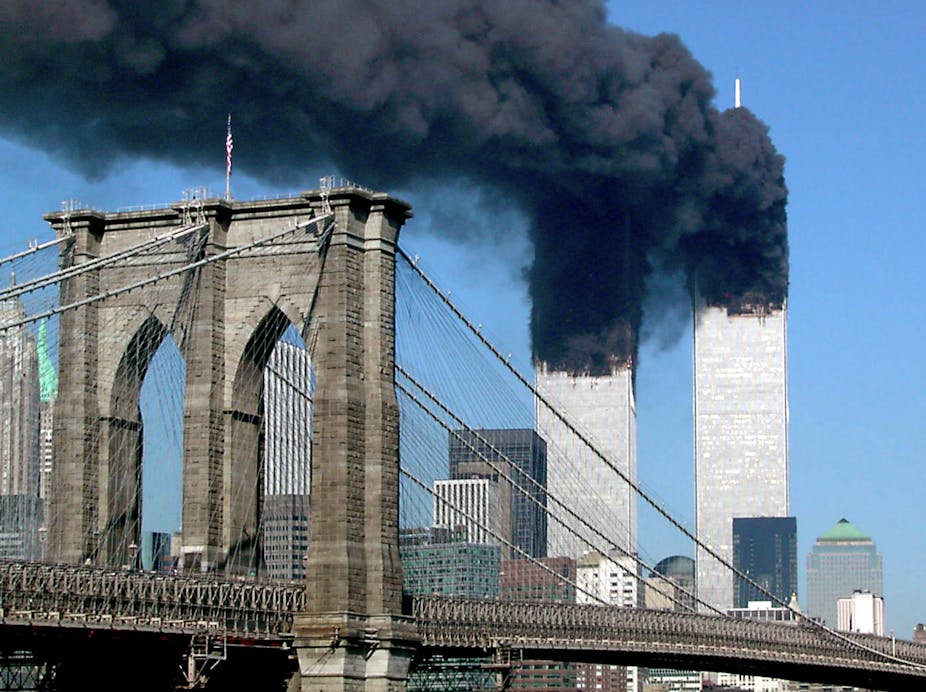“The hotel is being evacuated. Please return to your rooms and prepare to exit.” That was the first communication one of us, Dr. Terndrup, recalls receiving at a medical research meeting in the Brooklyn Marriott hotel that September morning.
Out on the street was pandemonium, Terndrup remembers. Just two miles from what would come to be called “Ground Zero,” people were running away from Manhattan. Members of our team – all medical professionals – split up to find ways to help. With a medic I had never met before, and whose name I didn’t ever learn, I walked across the Brooklyn Bridge, toward the World Trade Center site. Most people were heading the other way, of course.
The medic and I didn’t know quite what to do, though, because we didn’t know what was going on. We could see the smoke and ash covering much of the city skyline, as we headed in to help. Even the nonstop TV coverage didn’t give us many details we could use. Once we got to Manhattan, we got some useful information from police and other medics. But despite being in the heart of a major city with television cameras everywhere and thousands of emergency workers responding, it was challenging to get accurate, timely information.
What we and the other responders learned that day, under the pressure of a disaster of incredible scale, scope and urgency – not to mention the international media spotlight – went on to spark major changes in U.S. emergency response communication.
Setting up to respond

Once over the bridge and into lower Manhattan, the medic and I found our way to an office building off Vesey and Church streets, where we joined several dozen doctors, nurses, paramedics, police, firefighters and others hoping to help. We set up a makeshift clinic, including securing four elevators to stay on the ground floor to serve as “treatment rooms.” Then we waited.
When someone said there was a group of exhausted firefighters in a nearby bank, a few people went over to help rinse out their smoke- and dust-filled eyes (the most common problem) and help them use nebulizers (acquired from a nearby pharmacy) to combat the effects of smoke inhalation.
Communications were primitive at best. Cellular service was completely gone. In the first few minutes after the planes hit the towers, New York City’s 9-1-1 call centers received 3,000 calls – throughout that day, more than 55,000 came in.
Thousands of law enforcement officers and firefighters were trying to connect by phone, radio and two-way pager. Devices and networks, not to mention personnel, were overloaded. Police radios were generally working, but the best information was often by word of mouth.
At our office-building clinic, the volunteers resorted to face-to-face communication, sending people to meet up with a group of responders gathering on the nearby Pace University campus and bring back what information they could. The main message rapidly went from bad to worse. It could be summed up as, “There’s nobody coming out of that alive.”
Planning to communicate
While obviously both of us hope nothing like that ever happens again, as emergency responders it’s our job to plan for the unthinkably disastrous. No matter what, responders need to be able to deliver messages to the public, talk to hospitals, and connect with each other.
Since 1999, New York City’s Office of Emergency Management, charged with coordinating all aspects of the response, had occupied permanent headquarters in Seven World Trade Center, on Greenwich Street, just north of the landmark twin towers. A vital communications link was the radio repeater system based on the ground floor of One World Trade Center, the north tower. The loss of those facilities – and key personnel working there – significantly hampered the response.
Today, it’s considered a bad idea to put an emergency operations center near places likely to be direct targets or at risk for collateral damage. When building a new emergency-response headquarters, New York City put it across the East River in downtown Brooklyn, far from all potential targets and landmarks in lower Manhattan.
Making the connections
But that distance can be a weakness if communications are reduced, as we were, to sending messengers on foot to have face-to-face conversations to relay information.
Even if radios and phones are working, they’re much less useful if responders can’t talk to each other. In 2001, the Fire Department of New York, the New York Police Department and the Port Authority Police all used different radio systems with different capabilities on different frequencies. Unable to connect with each other, neither the agencies nor the rescuers themselves could efficiently coordinate to help victims. This disconnection may also have prevented the evacuation of responders before the buildings fell.
If leaders are to be farther away and yet still act rapidly in an unfolding situation, they need more than one way to communicate with each other and with people directly on the scene. When one system gets cut off or stops working properly, there must be other options.
Constructing resilience
In our work with Ohio’s FEMA Urban Search and Rescue Team, Task Force 1, we have multiple communication methods. Mainly we use a national wireless network – which itself is designed to be resilient in emergencies, with redundant network connections and switching equipment and round-the-clock system monitoring. The company can also bring in portable cellular towers when regular cell towers are disabled, or to improve coverage in an area where existing service is overloaded.
We have wireless service for the bus that serves as our mobile operations center, and for cell phones and tablets issued to our task force leaders. The bus also has a Wi-Fi system that can connect additional devices.
If the cellular network is severely compromised by the disaster, we can use satellites. MSAT devices carry our voice traffic, and our data travels via portable BGAN terminals, which connect to laptop computers.
Our base of operations (BoO) at a disaster is equipped with a 1.8-meter VSAT satellite dish that can provide data and internet access for all the responders in the area. As further backup, we have portable radios and a repeater system.
What we communicate about

Another communications lesson from 9/11 comes from something that, tragically, didn’t happen. That day, New York hospitals called in all available staff, to be ready to receive large numbers of patients. They worried, as did we, in our makeshift clinic just north of the twin towers, that thousands of people would need lifesaving care all at the same time.
Yet there was no way to know which hospitals were full, which ones had operating rooms available or anything else about where to send patients, had they arrived in large numbers. Some hospitals likely would have been beyond overwhelmed, while others nearby might have had plenty of space and available doctors and nurses standing ready.
The lesson has spread across the country. Columbus, Ohio, where we work now, uses a system called “Real Time Activity Status,” which connects all the hospitals in our own Franklin County and three neighboring counties. It notifies ambulance dispatchers when their emergency rooms are too busy and need to divert patients to other hospitals. A similar system saved many lives after the 2013 Boston Marathon bombing.
By ensuring that – no matter what happens – we can communicate with each other, the emergency response community keeps the memory of 9/11 alive in our own way every single day.

